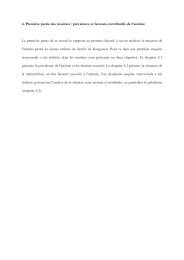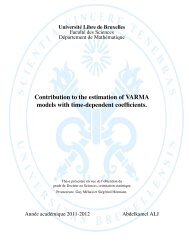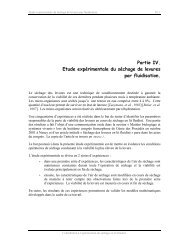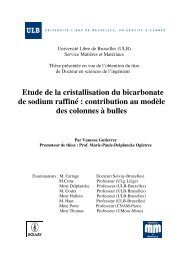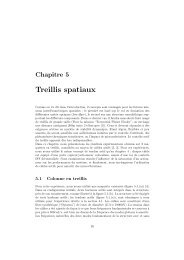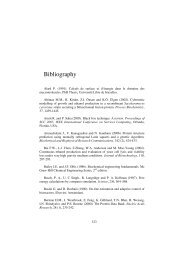Diapositive 1 - de l'Université libre de Bruxelles
Diapositive 1 - de l'Université libre de Bruxelles
Diapositive 1 - de l'Université libre de Bruxelles
You also want an ePaper? Increase the reach of your titles
YUMPU automatically turns print PDFs into web optimized ePapers that Google loves.
Chapitre Vin vivo by ion transport to and from the calcifying space, was suggested to induce andstabilize a transient magnesium-rich amorphous phase essential to the formation of highmagnesium calcites. Asp-rich proteins further stabilize this amorphous phase. Theinvolvement of the organic matrix in this process can explain the observation thatsympatric organisms or even different skeletal elements of the same individual presentdifferent magnesium concentration in the mineralized skeleton.INTRODUCTIONMarine invertebrates produce calcite skeletons with a large variety of chemicalcompositions and morphologies. These biogenic calcites are composed of a dominantmineral phase including an intimately associated organic phase. The mineral phase maycontain consi<strong>de</strong>rable concentrations of magnesium, ranging from a few percents up to43.5 mol% of MgCO 3 , as the major ion substituted to calcium in the mineral lattice(Chave 1954, Schroe<strong>de</strong>r et al 1969). Biogenic calcites may display higher magnesiumconcentrations than inorganically <strong>de</strong>posited calcites, produced either in nature or in thelaboratory (Cheng et al 2007, Wang et al 2009).The organic phase, the so-called organic matrix of mineralization, is mainly composed ofproteins and glycans. Despite its usually low concentration, the organic matrix ofmineralization plays an essential role in nucleation and crystal growth control. It affectsthe morphology of the <strong>de</strong>posited mineral and may <strong>de</strong>termine the precipitated polymorph(Lowenstam & Weiner 1989, Simkiss & Wilbur 1989, Addadi & Weiner 1992, Falini etal 1996). In particular, proteins enriched in the carboxyl-rich acidic amino acids aspartateand glutamate are thought to play a significant role in the modulation of biomineralformation (Addadi & Weiner 1985, 1992, Politi et al 2007, Stephenson et al 2008).Magnesium concentrations in marine biogenic calcites are known to vary according toenvironmental parameters, such as temperature, salinity and Mg/Ca ratio in seawater,which prompted the use of calcite skeletons as paleorecor<strong>de</strong>rs (Clarke & Wheeler 1922,Lea et al 1999, Lea 2003, Ries 2004, Borremans et al 2009, Hermans et al 2010a, 2010b).However, magnesium concentrations in the skeleton of closely related taxa living in thesame environment can be very different, indicating that biological factors, the so-called“vital effects”, are also involved (Weiner & Dove 2003, Bentov & Erez 2006). The natureof these effects is, in most cases, poorly un<strong>de</strong>rstood. Organic molecules and a biological94



